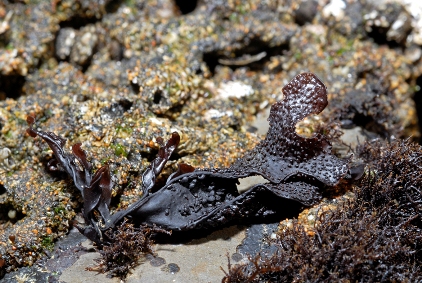
Adaptation
How does the organism hold on despite waves?
 One
such trait the organism has evolved, is called a holdfast. A
holdfast is a root-like structure at the base of the algae. It
fastens the algae to a hard substrate. Holdfasts are different
from roots in that they do not absorb moisture. The holdfast
makes sure that the organism doesn't drift along with the waves out
of the environment it has grown in. A change in the
environment could cause death to the organism. There are many
different variable that could change such as temperature, salt
concentration, and pH of the water. On the picture, you can
see the holdfast.
One
such trait the organism has evolved, is called a holdfast. A
holdfast is a root-like structure at the base of the algae. It
fastens the algae to a hard substrate. Holdfasts are different
from roots in that they do not absorb moisture. The holdfast
makes sure that the organism doesn't drift along with the waves out
of the environment it has grown in. A change in the
environment could cause death to the organism. There are many
different variable that could change such as temperature, salt
concentration, and pH of the water. On the picture, you can
see the holdfast.
Other adaptations have also been developed to help Mastocarpus papillatus hang in there.
Mastocarpus Papillatus can grow to a size of up to 15 cm tall. The morphology of Mastocarpus papillatus is variable. It is usually very flattened and can change in width. These major verifications arise from the different array of enviroments that Mastocarpus Papillatus can grown in. For example, if the environment has harsh waves it will grow to a smaller height and width. If the environment, has calm waves it will grow to a greater height and width. These variations help Mastocarpus Papillatus keep a hold of the substrate it is growing on. The reason for the flattened thalli, which are covered in varying sized papillae, is to increase the surface area to volume ratio.
What causes the red color?
Mastocarpus papillatus has developed a number of morphological adaptations that are extremely beneficial. These traits are paramount toward this organisms survival. A major adaptation is the development of phycoerithrin. Phycoerithrin is a pigment present in red algae that reflects red light and absorbs blue light. This allows for Mastocarpus papillatus to live in deeper ocean waters. You can read more about phycoerithrin and how this benefits Mastocarpus papillatus on the nutrition page.
Click here to go back to the Home Page.